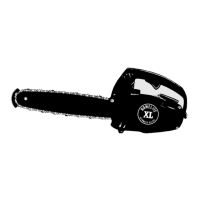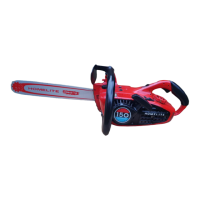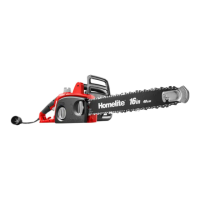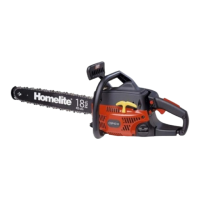IF CUT-OFF SECTION IS
LIKELY TO SETTLE AND
BIND
AGAINST CHAIN, BUCK ON
NGLE SO CUT OPENS UP
NOTE
A
wedge cannot be used with a SAFE*T*TIP@
(Pat.
Pending)
on the bar, unless you are sure that you can either remove
the wedge or roll the log so the saw can be retrieved from
the cut.
When pruning shade trees it is important not to make the
flush cut next to the main limb or trunk until you have lop-
ped off the limb further out to reduce the weight. This pre-
vents stripping the bark from the main member. Unless
the branch to be pruned is supported by another branch,
the stress will be downward (see illustration). Underbuck
the branch
1/3
through, then overbuck todrop the branch
off. Now make your finishing cut smoothly and neatly
against the main member so the bark will grow back to
seal the wound. Don't forget to paint the wound with a tree
preservative to prevent insect attacks and rot.
WHEN BRANCHES ARE TRIMMED NEATLY
FLUSH WlTH THE TRUNK AND THE WOUND PAINTED
WlTH A PRESERVATIVE. THE BARK CAN GROW
BACK TO SEAL THE
WOUND
SPRINGPOLES
A springpole is any log or branch or sapling which is bent
under tension by other wood so that it will spring back if
the wood holding it is cut or removed. Watch out for
springpoles. They are potentially dangerous.
THIS IS A SPRINGPOLE BENT
DOWN UNDER
HIGH STRESS
BORING WlTH THE NOSE SECTION
KICKBACK DANGER
There is a great possibility that the saw will kick back
during the start of the boring cut.
Boring should be attempted only by experienced oper-
ators because it requires extreme care and attention to
proper technique. Do not bore unless there is no other
way to make a cut. Boring is usually resorted to in order to
avoid an obstacle or when it is necessary to make blind
holes such as cut-outs for log cabin windows. The
SAFE*T*TlP@ (Pat. Pending) must be removed for a bor-
ing cut. Boring increases the chance of kickback
andalso
wears the chain and bar at an accelerated rate.
Study the panel illustrating a boring operation. As shown,
the danger will be minimized if you can make first contact
on the underside
of
the bar as far back from the bar nose
as you can get. Then cut downwardinto the wood until the
tip is buried in the cut. Gradually bring the saw level, then
bore through the wood to the full length of the blade. Now
you can cut either upward or downward through the wood
as shown in the panel.
BORING
-
-
.
-
. .
-
-
TECHNIQUE
1
MAKE FIRST
CONTACT ON
LOWER
QUADRANT
2
CUT DOWNWARD
TOBURYNOSE
OF SAW IN THE
WOOD AND ALIGN
SAW FOR THE BORE
4
CUT UPWARD OR
DOWNWARD AS
REQUIRED

